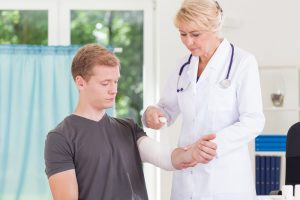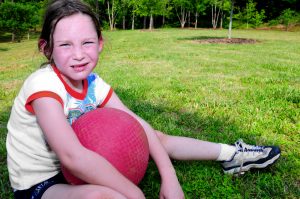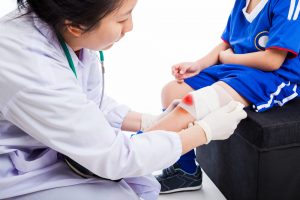Each year, 38 million children participate in organized sports in the United States. These activities not only provide numerous physical and social benefits; they also involve the huge risk of injury. The Centers for Disease Control and Prevention stated that more than 2.6 million children 0 to 19 years old are treated in the emergency room each year for sports injuries.
So today, let’s discuss common sports injuries in adolescents and ways to prevent and treat these injuries.
Common Sports-Related Injuries in Kids
From scrapes and bruises to serious brain and spinal cord injuries; sports injuries can fall anywhere in between. Some of the most common types include the following:
Sprains and Strains
 Although they share similar signs and symptoms, sprains and strains involve different parts of your body. Strains stretch or tear the muscle or tendon, a fibrous cord of tissue that connects two bones in your joints. The most common location for strains is in the ankle. Sprains stretch and tear ligaments, which are the bands of fibrous tissue connecting two bones together in your joints. Strains are often in the hamstring muscle, the back of your thigh or in the lower back. Sports like basketball, track and field, football and gymnastics are examples of where sprains and strains can take place.
Although they share similar signs and symptoms, sprains and strains involve different parts of your body. Strains stretch or tear the muscle or tendon, a fibrous cord of tissue that connects two bones in your joints. The most common location for strains is in the ankle. Sprains stretch and tear ligaments, which are the bands of fibrous tissue connecting two bones together in your joints. Strains are often in the hamstring muscle, the back of your thigh or in the lower back. Sports like basketball, track and field, football and gymnastics are examples of where sprains and strains can take place.
Growth Plate Injuries
A fall or blow to the limb can result from an injury in the growth plate. In children, a serious injury to a joint is more likely to damage a growth plate than the ligaments that stabilize the joint. These injuries occur twice as often in boys than girls in sports such as:
- Football
- Basketball
- Gymnastics
- Biking/Skateboarding
- Sledding/Skiing
[Tweet “From scrapes and bruises to serious brain and spinal cord injuries; sports injuries can fall anywhere in between”]
Heat-related Issues
 Not properly taking care of your self in the heat is always dangerous and can be fatal. Children generally perspire less than adults and require a higher core body temperature thus making them prone to heat-related injuries. These issues may include the following:
Not properly taking care of your self in the heat is always dangerous and can be fatal. Children generally perspire less than adults and require a higher core body temperature thus making them prone to heat-related injuries. These issues may include the following:
- Heat Stroke – Symptoms may include dizziness, headache and confusion
- Dehydration – Occurs when the loss of water exceeds the amount taken in. Symptoms may include increased thirst, dry mouth, weakness, confusion and fainting
- Heat Exhaustion – May include dizziness, nausea, weakness, headaches, pale skin, heavy perspiration, low body temperature, dilated pupils and fainting spells
Repetitive Motion Injuries
Injuries make up more than half of all athletic-related injuries seen by doctors. Surprisingly, everyday activities such as throwing a ball, scrubbing a floor or jogging can cause this condition. These painful injuries such as stress fractures (a hairline fracture of the bone that has been subjected to repeated stress) and tendinitis (inflammation of a tendon) can occur from overuse of muscles and tendons. Generally, these injuries do not show up on x rays, but they do cause pain and discomfort. The RICE method, mentioned below is ideal for at-home treatment.
[Tweet “more than 2.6 million children 0 to 19 years old are treated in the emergency room each year for sports injuries.”]
Preventing and Treating Injuries
Injuries may occur to any child playing sports, but there are ways to help prevent and treat injuries.
- Make sure, no matter the sport, your child has proper protective gear such as goggles, shin guards, etc.
- Proper stretching is key to avoiding any injuries such as sprains or strains.
- Warm-up and cool down exercises can be integrated in your child’s routine to avoid injury. Warming up with light jogging in place or jumping jacks make the body’s tissues more flexible. Cool down like stretching loosens the muscles that tightened during playing time.
 When it comes to treatment for sports-related injuries, the RICE method is ideal in many situations. RICE is broken down into the following steps:
When it comes to treatment for sports-related injuries, the RICE method is ideal in many situations. RICE is broken down into the following steps:
Rest: Avoid using the injured area for at least 48 hours. If you’re suffering from a leg injury, avoid using the leg completely.
Ice: For 20 minutes at a time for four to eight times per day, put an ice pack on the injured area. We suggest using a cold pack or a plastic bag filled with crushed ice that has been wrapped in a towel.
Compression: To reduce swelling, ask your child’s doctor about elastic wraps, special boots or splints to compress an injured ankle, knee or wrist.
Elevation: The injured area needs to be elevated above your heart to help decrease swelling. Use a pillow to help elevate any injury.
Speak with your child’s primary care physician for more serious injuries that do not respond to basic first aid. As an added benefit, the staff at Beaumont Emergency Hospital is always available to diagnose and provide treatment for sports-related injuries for young athletes.
